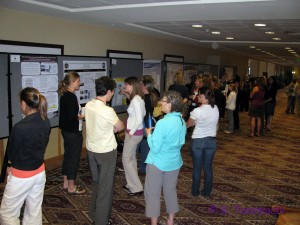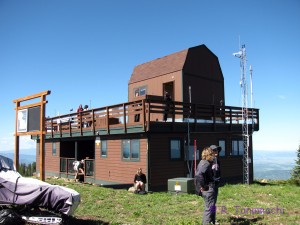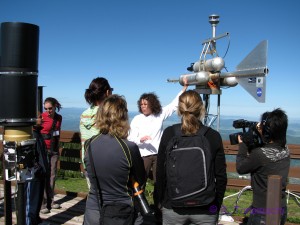This past week, I was privileged to participate in the third annual Atmospheric Science Collaborations and Enriching Networks (ASCENT) workshop in Steamboat Springs, Colorado.* This workshop brings together female atmospheric scientists at different stages of their respective academic careers, about half of them recent Ph.D. recipients (junior scientists). Throughout the three-day workshop, the senior scientists shared their career stories and life lessons, while the junior scientists discussed their work via poster session and sought out collaborators. There was even a film crew – a media budget was written into the ASCENT grant – who documented the workshop, interviewed us, and shot tons of images and video that will soon be on the web for the world to see.



Doubtless there has never been a better time to be a female atmospheric scientist. Most of the overt barriers to women in science have been removed, thanks to laws (such as the Civil Rights Act and the Family and Medical Leave Act) that have been informed by science. I am happy to report that I have never experienced overt discrimination or harassment in my career – at least, not that I have been aware of.
However, when I walked across the stage at the OU School of Meteorology graduation ceremony this spring to receive my doctoral hood, I was the only female Ph.D. recipient out of 10. Why was I there, while my other female classmates chose to stop at the B.S. and M.S. levels? I’ve chatted with some of them informally; the familiar refrain is that they worry that they will not be able to sustain the energy level and workload required of an academic researcher. We see our professors come in late at night to slave away on grant proposals and papers. I must admit that the “lifestyle” doesn’t look all that appealing. Literature with titles like Where are All the Women Geoscience Professors?, Why So Slow?, and Why So Few? abound. I was saddened to learn that meteorology suffers from the lowest rate of female professorship among all the geosciences – In 2010, just a scant 12% of meteorology professors were women.
During the workshop, we shared strategies for coping with workplace issues that disproportionately affect women. There were plenty of horror stories from women who had suffered active discrimination, who were denied credit for work they did, who were rejected for positions on account of motherhood, and who had suffered resentment, harassment, or even assault by colleagues. But that was then; don’t we live in more enlightened times now? Not according to the statistics. It appears that many of the barriers left for us now are actually unconscious ones, either in our own minds or the minds of others. While many of us will swear to rejecting stereotypes of female scientists, our actions betray our unconscious biases. There’s the “bitch” dilemma – How does a woman assert herself without coming off as a bitch? (Consensus answer: “Be persistently pleasant.”) There are studies showing that women are held to higher standards of competence than men, women are less likely to negotiate for fear of appearing pushy, are pressed to do more service than men (“token woman syndrome”), and are more likely to have their credentials overlooked or questioned. We learned strategies for saying “no,” for compartmentalizing our time, for leveraging our institutions’ policies during demanding family times, for supporting other women (which is actually a major problem), and for gently reminding others of our need for space and respect.
Not all the strategies were abstract or hypothetical. For example, those of us who had not yet written grant proposals were invited by a participant from NSF to submit our names as potential proposal reviewers (thereby learning by reviewing what works and what doesn’t). I did not know that opportunity existed, because I assumed I had to submit a proposal before I would be asked to review, as in academic journals. (Major lesson: What you assume can hurt you! Always ask!) We were asked to participate in real-world research projects, select mentors, and continue correspondence after the end of the workshop. And of course, being a good science project, ASCENT included lengthy evaluation metrics and assurances that we will be checked up on periodically in the future to assess the impacts of the workshop.
As much as I enjoyed ASCENT, and as much as I can see the merits of gathering women in an all-female setting to share their strategies, I cannot help feeling that the very concept of “women’s issues” is still a major impediment. These are men’s issues, too. Men work and live with women. What good does it do women to gather and discuss ways to deal with the male-centric framework of scientific research, when it’s the framework itself that needs changing, and will require the involvement of men to change it? It’s not enough for a male scientist to simply say, “I’m not sexist, so I’m not part of the problem.” I once pointed out to my doctoral adviser that he now has a vested interest in ensuring a level playing field for me after graduation, because he has invested a great deal of time and money in my professional development. (To his credit, he has always let me have first authorship on papers I have written myself, and allowed me to present my own work whenever possible. I am shocked to hear that, even today, this is not always the case!)
My male colleagues should recognize that support for their female colleagues is not an accommodation that dilutes science, but a strategy for synergy and increased productivity throughout the whole of science. When the potential of half the scientist population is not being fully realized, that dilutes science. Happier, healthier, more productive colleagues (both male and female) will benefit everyone in the long run, and ultimately make our nation’s science stronger.
*I first heard about ASCENT through the Earth Science Women’s Network mailing list. ASCENT was organized by the Desert Research Institute, and funded by NSF. CAPS supported my travel to and from ASCENT.
Some of the statistics and publications to which I refer, as well as many more, can be found in this list.